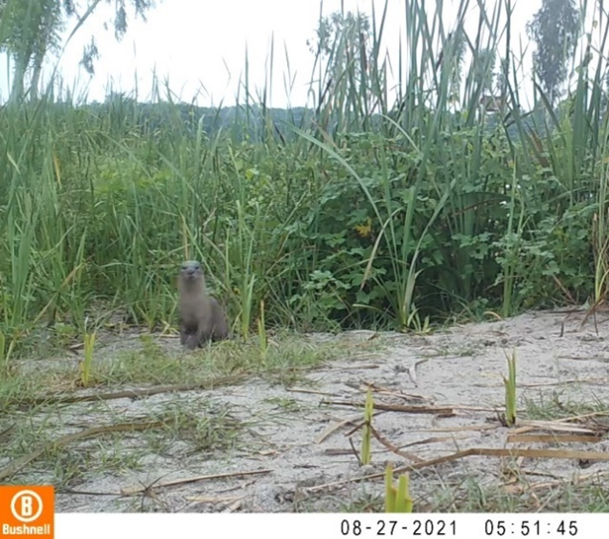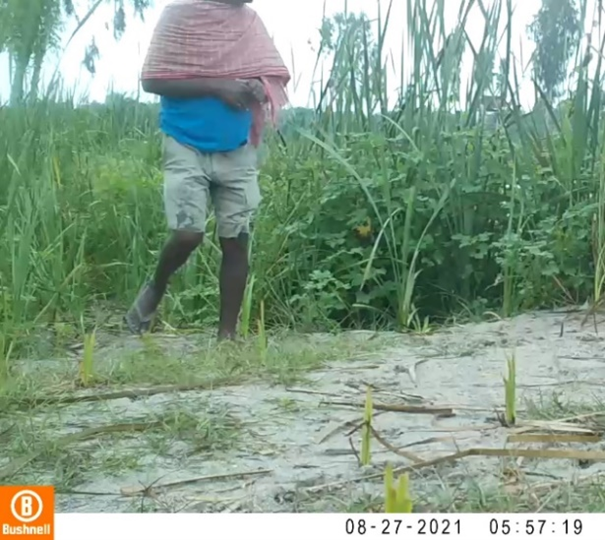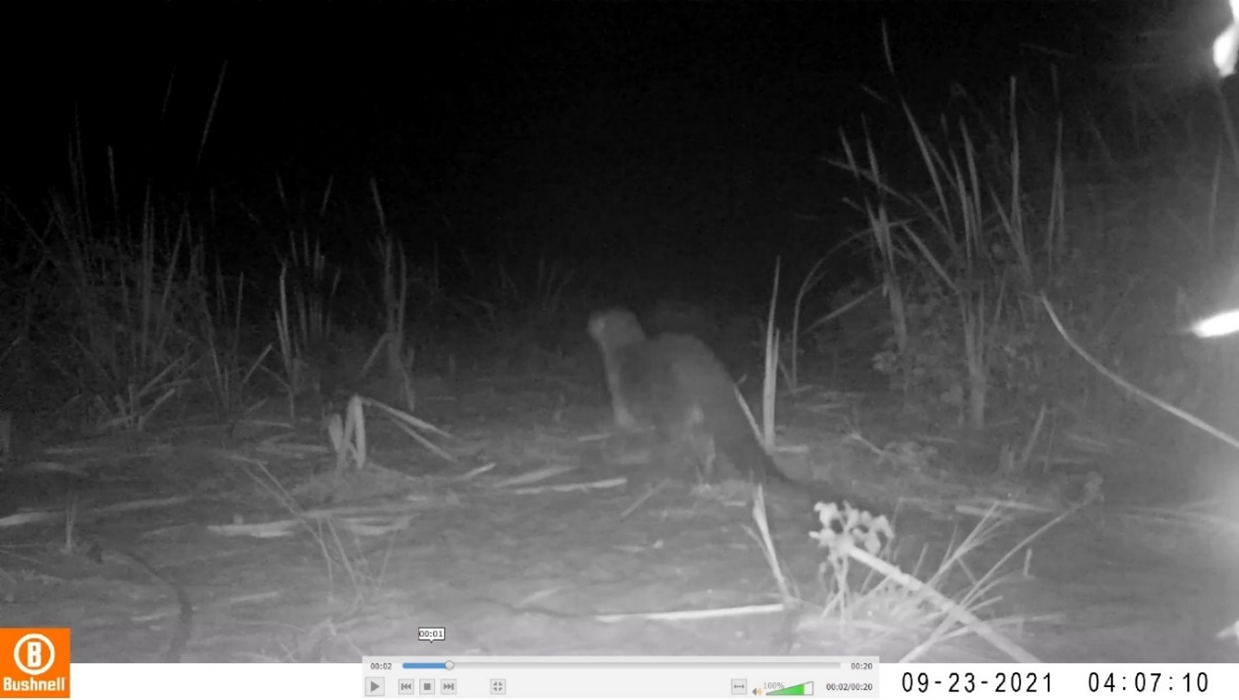IUCN/SSC Otter Specialist Group Bulletin

©IUCN/SCC Otter Specialist Group
Volume 39 Issue 4 (November 2022)
Citation: Mishra, R., Lamichhane, B.R., Gautam, B., Ram, A.K., and Subedi, N. (2022). Photographic Evidence of Smooth-Coated Otter Lutrogale perspicillata in Koshi Tappu Wildlife Reserve, Nepal IUCN Otter Spec. Group Bull. 39 (4): 189 - 195
Photographic Evidence of Smooth-Coated Otter Lutrogale perspicillata in Koshi Tappu Wildlife Reserve, Nepal
Rama Mishra1,2*, Babu Ram Lamichhane3, Birendra Gautam3, Ashok Kumar Ram4, and Naresh Subedi3
1Evolutionary Ecology Group, Department of Biology, Antwerp University, Belgium
2Wildlife Conservation Association Nepal (WildCAN), Babarmahal, Kathmandu, Nepal
3National Trust for Nature Conservation, Lalitpur, Nepal
4Department of National Parks and Wildlife Conservation, Kathmandu Nepal
*Corresponding Author Email: l.mishrarama@gmail.com
(Received 29th January 2022, accepted 25th June 2022)
Abstract: Smooth-coated otter Lutrogale perspicillata is one of the three otter species occur in Nepal. They were believed to be extirpated from central and eastern Nepal. Camera traps set to study fishing cats in the buffer zone area of Koshi Tappu Wildife Reserve recorded smooth-coated otters, confirming their presence in the protected area. Single individuals of smooth-coated otter were recorded at two locations in three detections. The recorded locations lie at the elevated edge of Typha elephantina dominated swamps, created from the Koshi River seepage near the Koshi embankment. Regular monitoring and conservation efforts for the smooth-coated otter are needed to ensure their survival in Koshi.
Keywords: Smooth-coated otter, Koshi Tappu Wildlife Reserve, community fish ponds, Buffer Zone, Nepal, Camera trapping
INTRODUCTION
The status of the three species of otters purported to inhabit Nepal is unclear. The presence of the smooth-coated otter (Lutrogale perspicillata) in the lowland Terai is well documented (e.g. Acharya and Lamsal, 2010; Acharya, 2016; Joshi et al., 2021). The Eurasian otter (Lutra lutra) was recently reported at higher elevations in the country after an absence of three decades (Basnet et al., 2020; Shrestha et al., 2021). The small-clawed otter (Aonyx cinerea) has been anecdotally reported in Nepal (Kafle, 2009; Jnawali et al., 2011) but has not been confirmed since the 19th century (Hodgson 1841).
The smooth-coated otter is the only extant representative of the genus Lutrogale (White 2004). It is a globally threatened otter species, listed as ‘Vulnerable’ in the IUCN Red List (Khoo et al., 2021) and Appendix I of CITES (2021), with patchy distribution across South and Southeast Asia (Khoo et al., 2021).
In Nepal, the smooth-coated otter is an endangered species but not included in the protected list of the National Parks and Wildlife Conservation Act, 1973 (Jnawali et al., 2011). Recent surveys suggest their distribution is restricted to the western Terai primarily in Bardia and Shuklaphanta National Parks. Habitat conditions within their distribution range appears to be declining continuously (Jha, 2018). A study carried out in Koshi Tappu Wildlife Reserve in 2002 found no sign of otters (Jha et al., 2020) and there has been no evidence of their presence in the KTWR since. Here, we present photographic evidence of smooth-coated otters in fish farming areas in the buffer zone of Koshi Tappu Wildlife Reserve.
MATERIALS AND METHODS
Study area
This study was carried out in eastern Buffer Zone of Koshi Tappu Wildlife Reserve (KTWR, location: 86°55′ - 87°05′ E and 26°34′ - 26°45′ N) in southeastern Nepal (Figure 1). KTWR, established in 1976, covers an area of 175 km2 and became the first Ramsar site of Nepal in 1987. An additional 173 km2 surrounding the reserve was declared a buffer zone in 2004. The reserve provides habitat for many globally threatened mammals, reptiles and birds including wild water buffalo Bubalus arnee, fishing cat Prionailurus viverrinus, gharial crocodile Gavialis gangeticus, Bengal florican Houbaropsis bengalensis (Chettri et al., 2013). KTWR is characterized by a freshwater ecosystem with sand beaches, grasslands and forest patches and lies in the floodplain of the snow-fed Koshi River, the largest river of Nepal and a major tributary of the Ganga River. However the land cover is changing rapidly and wetlands are decreasing due to anthropogenic and climatic factors (Chettri et al., 2013; Chaudhary et al., 2016) affecting the entire wetland ecosystem (Mishra et al., 2020; 2021).

In the eastern buffer zone of the KTWR an area of continuous wetlands is formed by the water seepage through the embankment of Koshi River. It provides habitats for several species of fishes, amphibians, crustaceans, molluscs, birds and small mammals (Mishra et al. 2021). Communities have converted most of this seepage area within their private land into the fish farms. These farms are also frequently used by aquatic fauna such as fishing cat, otters, crocodiles, and birds, leading to intense human-wildlife interaction.
Camera trap survey
We conducted a camera trap survey during the monsoon and post-monsoon season (July–November) in 2021. The survey was primarily targeted at fishing cats to monitor their movement around the fishponds in eastern BZ of KTWR. We set digital motion sensor cameras (Bushnell Trophy Cam HD) in 3 sites 5 kilometer apart (5 cameras in site A and two cameras each in Site B and C) (Figure 1). The distance between the camera locations within each site varied from 200–500 m. Since the cameras were location within a 500 m area, we considered the images collectively as representing a single locality. Camera traps were active day and night for 4 months and checked twice a week. The camera traps were programmed to take either 3 photos per trigger or a video of 20 seconds. GPS coordinates were recorded during the camera installation using a Garmin eTrex 10 GPS receiver. Data was downloaded in systematic folders and sorted by species. Standard detection rate (number of detections of a species per 100 trap nights) was calculated.
RESULTS
Three independent detections of smooth-coated otters at 2 locations were obtained in camera traps with a total effort of 360 trap days. The camera traps recorded video clips, 20 second long in each detection of a single individual (Figure 2). We could not identify the individuals and sex, thus, could not confirm whether it is the same individual recorded repeatedly, or, different individuals. The other species captured in camera traps were Asian elephant Elephas maximus, wild water buffalo, fishing cat, jungle cat Felis chaus, small Indian civet Viverricula Indica, common palm civet Paradoxurus hermaphroditus, golden jackal Canis aurenus, Indian crested porcupine Hystrix indica, rhesus monkey Macaca mulatta, marsh mugger crocodile Crocodylus palustris, a few rodents and several species of birds. Besides wildlife, camera traps had also recorded humans, domestic cats and dogs, goats, buffaloes, and cattle.
DISCUSSION
We present conclusive evidence of smooth-coated otters from the buffer zone of KTWR in the eastern Terai of Nepal, in a camera trap survey for fishing cats. Both fishing cats and otters are wetland habitat specialists, sharing wetland habitats.
Camera trap surveys conducted in 2016 and 2017, with a trap effort of 140 and 385 active trap days respectively, were unsuccessful in confirming otter presence in the Koshi Tappu area (Mishra et al., 2021). No detection of otters at that time could be due to their low density or a short camera trapping period (7-10 days at a location and 2 months of total survey period). However, otters may have been locally extinct and recolonized in the Koshi Tappu area. The survey of Mishra et al. (2021) was conducted in the dry season (November-January) when the water level in the Koshi River was low in comparison to the monsoon and post-monsoon flooding season.
No otter scats were observed during the survey, suggesting that otters are rare in KTWR. Many of the swamps in the area are now converted into commercial fish farms, and otters may be using this habitat for foraging, as described by Hussain and Choudhury (1997). In addition to the images of otters from this survey, several fish farmers reported the sighting of an individual otter foraging in their fish pond area during the time period of our survey. In an informal interview with the first author, one of the farmers also reported seeing four otters together at the same locality in October, 2021.
The wetlands in the Terai of Nepal face many threats, including the construction of irrigation dams, uncontrolled groundwater pumping, dumping of untreated industrial waste in water source, domestic sewage, pesticides and herbicides, use of chemical fertilizers in agricultural field, sedimentation and eutrophication (Karki and Thomas, 2004). In Koshi Tappu, sand and gravel extraction, driftwood collection, overfishing using gillnets and/or electrocution, all have an adverse impact on species abundance and diversity in these wetlands (Karki and Thomas, 2004).
Our study confirms that the existence of smooth-coated otters in Koshi Tappu. We could not confirm whether otters remained in the Koshi undetected by researchers or it was extirpated for some years and recolonized in Koshi. The occurrence of otters in the fish farming sites and their predation on fish suggests persecution threats from fish farmers. Conservation efforts for the smooth-coated otter and awareness among stakeholders, including local fish farming communities, are urgently needed to ensure their survival. Regular monitoring of otters and other aquatic fauna should be conducted. A detailed study of smooth-coated otter ecology and interaction with fish farming communities is recommended to foster otter conservation in the highly human-dominated landscape like Koshi Tappu.
REFERENCES
Acharya, P.M. (2016). Investigations of population and habitats of smooth coated otter Lutrogale perspicillata in Karnali River Systems of Bardia National Park. A research report submitted to Hariyo Ban Programme/WWF Nepal.
Acharya, P.M., Lamsal, P. (2010). A survey for smooth coated otter Lutrogale perspicillata on the River Narayani, Chitwan National Park, Nepal. Hystrix 21: 2. https://doi.org/10.4404/hystrix-21.2-4464
Basnet, A., Bist, B.S., Ghimire, P., Acharya, P.M. (2020). Eurasian otter (Lutra lutra): Exploring evidence in Nepal. IUCN Otter Specialist Group Bulletin 37: 29-37. https://www.iucnosgbull.org/Volume37/Basnet_et_al_2020.html
Chaudhary, S., Chettri, N., Uddin, K., Khatri, T.B., Dhakal, M., Bajracharya, B., Ning, W. (2016). Implications of land cover change on ecosystems services and people’s dependency: A case study from the Koshi Tappu Wildlife Reserve, Nepal. Ecological complexity 28: 200-211. https://doi.org/10.1016/j.ecocom.2016.04.002
Chettri, N., Uddin, K., Chaudhary, S., Sharma, E. (2013). Linking Spatio-temporal land cover change to biodiversity conservation in the koshi tappu wildlife reserve, Nepal. Diversity 5: 335-351. https://doi.org/10.3390/d5020335
CITES (2021). Appendices. Available at: https://cites.org/eng/app/appendices.php [accessed 9 January 2022]
Hodgson, B.H. (1841). Classified catalogue of the mammals of Nepal. Journal of Asiatic Society of Bengal 10: 907–916.
Hussain, S.A., Choudhury, B.C. (1997). Distribution and status of the smooth-coated otter Lutra perspicillata in National Chambal Sanctuary, India. Biological Conservation 80: 199-206. https://doi.org/10.1016/S0006-3207(96)00033-X
Jha, R.R. (2018). Distribution Status of Smooth Coated Otters (Lutrogale perscipillata) and Anthropogenic Factors: A Case Study from Karnali Corridor, Nepal. Tribhuvan University.
Jha, R.R., Silwal, T., Yoxon, G.M., Shahi, K., Nepali, H., Joshi, A.K. (2020). Status of Otters in Nepal: A Link with Ancient Waterways and People. In ‘Hindu Kush-Himalaya Watersheds Downhill: Landscape Ecology and Conservation Perspectives’. (Eds G. R. Regmi and F. Huettmann.) pp. 409-418. (Springer.)
Jnawali, S.R., Baral, H.S., Lee, S., Acharya, K.P., Upadhyaya, G.P., Pandey, M., Shrestha, R., Joshi, D., Lamichhane, B.R., Griffiths, J., Khatiwada, A.P., Subedi, N., Amin, R. (2011). The Status of Nepal’s Mammals: The National Red List Series. (Department of National Parks and wildlife Conservation: Kathmandu, Nepal.). ISBN: 978-0-900881-60-2. Available at: http://awsassets.panda.org/downloads/nepal_redlist_low_09_06_2012_1.pdf
Joshi, G.K., Joshi, R., Poudel, B. (2021). Distribution and threats to Smooth-Coated Otters Lutrogale perspicillata (Mammalia: Carnivora: Mustelidae) in Shuklaphanta National Park, Nepal. Journal of Threatened Taxa 13, 19475-19483. https://doi.org/10.11609/jott.7322.13.11.19475-19483
Kafle, G. (2009). A review on Research and Conservation of Otters in Nepal. IUCN Otter Specialist Group Bulletin 26: 32–43. https://www.iucnosgbull.org/Volume26/Kafle_2009.html
Karki, S., Thomas, S. (2004). A Review of the Status and Threats to Wetlands in Nepal. Retrieved from https://policycommons.net/artifacts/1376694/a-review-of-the-status-and-threats-to-wetlands-in-nepal/1990958/ on 25 Jun 2022. CID: 20.500.12592/jb1kg3.
Khoo, M., Basak, S., Sivasothi, N., de Silva, P.K. & Reza Lubis, I. (2021). Lutrogale perspicillata.
The IUCN Red List of Threatened Species 2021: e.T12427A164579961. https://dx.doi.org/10.2305/IUCN.UK.2021-3.RLTS.T12427A164579961.en
Mishra, R., Gautam, B., Kaspal, P., Shah, S.K. (2021). Population status and threats to fishing cat Prionailurus viverrinus (Bennett 1833) in Koshi Tappu Wildlife Reserve, Eastern Nepal. Nepalese Journal of Zoology 5: 14-22. https://doi.org/10.3126/njz.v5i1.38284
Mishra, R., Gautam, B., Shah, S.K., Subedi, N., Pokheral, C.P., Lamichhane, B.R. (2020). Opportunistic records of jungle cat (Felis chaus) and their activity pattern in Koshi Tappu Wildlife Reserve, Nepal. Nepalese Journal of Zoology 4: 50-55. https://doi.org/10.3126/njz.v4i1.30673
Shrestha, M.B., Shrestha, G., Reule, S., Oli, S., Ghartimagar, T.B., Singh, G., Tripathi, D.M., Law, C.J., Shah, K.B., Savage, M. (2021). First evidence of Eurasian otter in Nepal in three decades. IUCN Otter Spec. Group Bull 38, 279-291. https://www.iucnosgbull.org/https://iucnosgbull.org/Volume38/Shrestha_et_al_2021b.html
White, T. (2004). Lutrogale perspicillata smooth-coated otter. Animal Diversity Web. Available at: https://animaldiversity.org/accounts/Lutrogale_perspicillata/ [accessed 11 January 2022]
Résumé: Preuve Photographique de la Loutre à Pelage Lisse Lutrogale perspicillata dans la Reserve de Faune Sauvage de Koshi Tapu au Nepal
La loutre à pelage lisse Lutrogale perspicillata est l’une des trois espèces de loutres présentes au Népal. On pensait qu’elles avaient disparu du centre et de l’est du Népal. Des pièges photographiques installés en vue de l’étude du Chat viverrin dans la zone tampon de la réserve faunique de Koshi Tappu ont enregistré des loutres à pelage lisse, confirmant leur présence dans la zone protégée. Des individus isolés de loutres à pelage lisse ont été enregistrés sur deux sites, lors de trois détections. Les sites d’enregistrement surplombent les marécages dominés par Typha elephantina, créés par les suintements de la rivière Koshi près du remblai de Koshi. Des efforts réguliers de surveillance et de conservation de la loutre à pelage lisse sont nécessaires pour assurer sa survie à Koshi.
Revenez au dessus
Resumen: Evidencia Fotográfica de Nutria Lisa Lutrogale perspicillata en la Reserva de Vida Silvestre Koshi Tappu, Nepal
La nutria lisa Lutrogale perspicillata es una de las tres especies de nutria que viven en Nepal. Se cree que fue extirpada de Nepal central y oriental. Cámaras-trampa dispuestas para un estudio de gatos pescadores en la zona buffer de la Reserva de Vida Silvestre Koshi Tappu, registraron nutrias lisas, confirmando su presencia en el área protegida. Se registraron individuos solitarios de nutria lisa en dos locaciones, en tres detecciones. Las locaciones se encuentran en el borde elevado de los pantanos dominados por Typha elephantina, creados a partir de la infiltración del Río Koshi cerca del terraplén Koshi. Se necesitan monitoreo regular y esfuerzos de conservación para la nutria lisa, para asegurar su supervivencia en Koshi.
Vuelva a la tapa
सारांश
खैरो ओंत अर्थात 'स्मुथ कोटेट ओटर' नेपालमा पाइने तीन ओंत प्रजाति मध्ये एक हो। यसको वैज्ञानिक नाम लुट्रोगेल पर्स्पिसिलटा हो। खैरो ओंतलाई मध्य र पूर्वी नेपालबाट लोप भएको आशंका गरिएको थियो। कोशी टप्पु वन्यजन्तु आरक्षको मध्यवर्ती क्षेत्रमा मलाहा बिरालो अर्थात ‘फिसिङ क्याट’को अध्ययन गर्न राखिएका स्वचालित क्यामेरा ट्र्यापहरूले तिनीहरूको उपस्थिति पुष्टि गर्दै खैरो ओंत रेकर्ड गरेका हुन्। दुई स्थानहरूमा जम्मा तीनपटक खैरो ओंतको तस्विर कैद भएका छन्। रेकर्ड गरिएका स्थानहरू कोशीको तटबन्धन नजिकै पटेर ‘टाइफा एलिफेन्टिना’ को प्रभुत्व भएको सीमसार क्षेत्रमा अवस्थित छन्। कोशीमा खैरो ओंतको अस्तित्व सुनिश्चित गर्नको लागि तिनीहरूको नियमित अनुगमन र संरक्षण गतिविधिहरु आवश्यक छ।
Rसुरुमा फर्कनुहोस्







